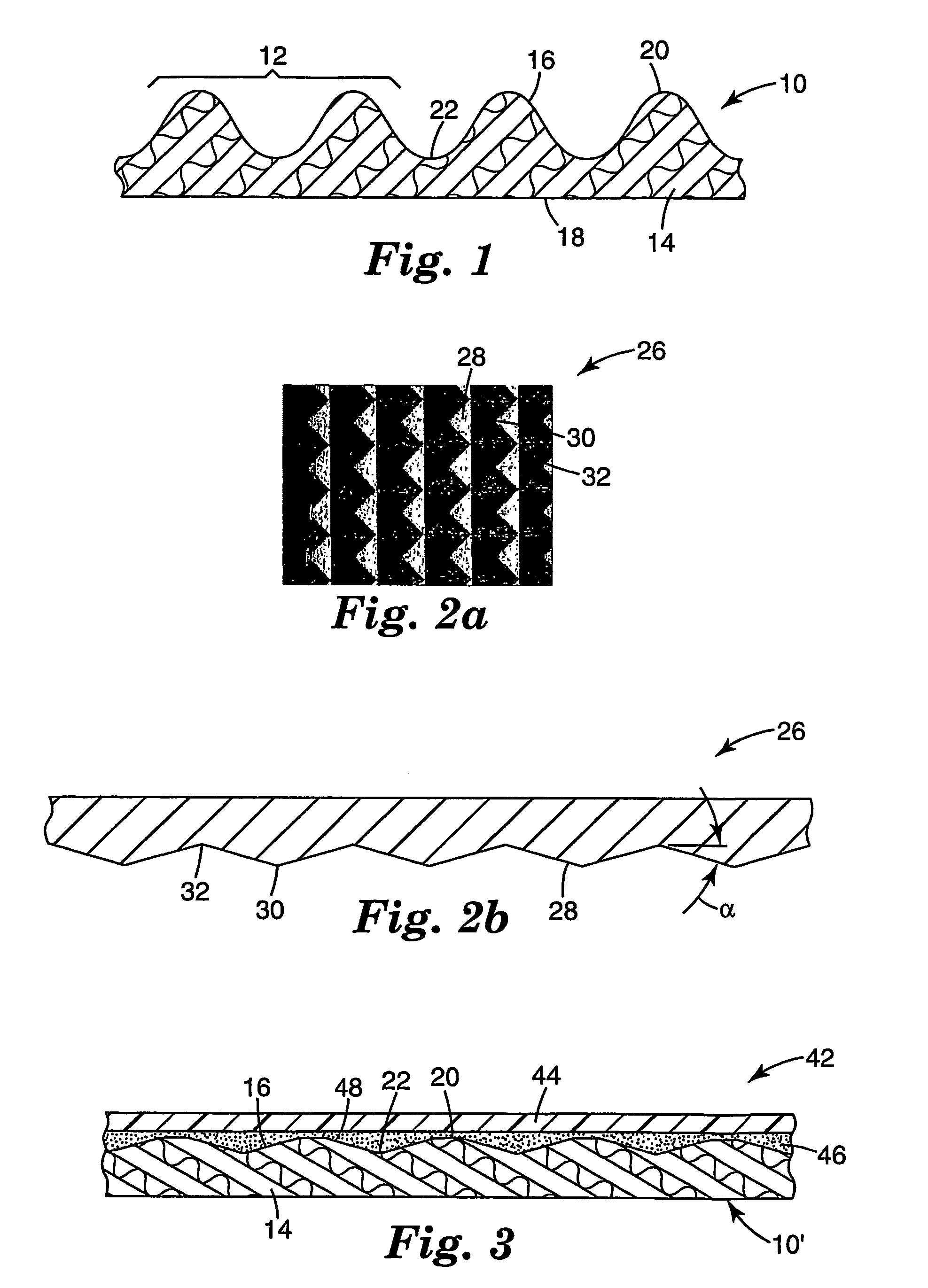Structured paper release liner, adhesive-backed article assembly and method of making same
a technology of structured paper and release liner, which is applied in the field of release liner, can solve the problems of loss of pattern structure formed in the thermoplastic structural support layer, all or part of the pattern structure formed in the structural support layer can be degraded or lost, and achieve the effects of reducing efficiency, increasing costs, and speeding up rates
- Summary
- Abstract
- Description
- Claims
- Application Information
AI Technical Summary
Benefits of technology
Problems solved by technology
Method used
Image
Examples
example 1
Preparation of the Micro-Embossed Paper Release Liner
[0081]An metal embossing plate was cut with a diamond tool and formed by means of a standard electrogalvanic procedure to provide a three dimensional pyramidal pattern having a pitch of about 300 μm between the structural elements (i.e. from pyramid tip to pyramid tip with 87 lines per inch) a height of 25 μm and an angle of 10° between the top of the pyramid and the base of the pyramid.
[0082]An industrial release paper for PSA release having an area weight of 137+ / −8 g / m2 and a thickness of 153 μm+ / −10 μm, commercially available as Rubesil ZU 135 / 368 from 4P Rube Huhtamaki, Goettingen, Germany, was used as a base material for embossing. The paper has low curling properties, a medium smooth backside, a machine direction tensile strength greater than 8 kN / m (cross direction greater than 3.5 kN / m) and an Elmendorf tear strength of CD greater than 900 mN (CD greater than 700 mN). The paper is 100% bleached and is clay coated on both ...
examples 2-3
[0092]Example 1 was repeated except that the depth of the microstructure in the release liner was altered by increasing the pressure on the embossing tool from 200 bar to 250 and 330 bar, respectively.
[0093]The liner of Example 3 was tested with results as follows: The Elmendorf tear strength in the cross direction was compared to the cross direction tear strength of an unembossed paper. Both papers had tear strengths of about 60 Elmendorf units. The tear strength of Example 3 had MD / CD tear strengths (in kN / m) of 9.6 / 5.3; the unembossed paper had respective tear values of 9.8 / 5.2. Example 3 had a liner release force of 0.9 N / 2.54 cm and a 180° Peel adhesion of 24.05 N / 2.54 cm.
[0094]
TABLE 1Emboss-Emboss-Appear-ingCalc.ingAirancePressureForceTimePitchDepthbleed-(withExBarN / cm2secondsμmμmabilityliner)12001006602976.610Good22501257602978.222Good333016596029712.338Good
example 4
[0095]A microstructured liner was prepared as in Example 1 except that the embossing plate was cut to provide a square pyramidal pattern with a pitch of 200 micrometers, a depth of 13 micrometers, and a distance between the tops of the pyramids of 20 micrometers.
PUM
| Property | Measurement | Unit |
|---|---|---|
| shallow angle | aaaaa | aaaaa |
| diameter | aaaaa | aaaaa |
| thickness | aaaaa | aaaaa |
Abstract
Description
Claims
Application Information
 Login to View More
Login to View More - R&D
- Intellectual Property
- Life Sciences
- Materials
- Tech Scout
- Unparalleled Data Quality
- Higher Quality Content
- 60% Fewer Hallucinations
Browse by: Latest US Patents, China's latest patents, Technical Efficacy Thesaurus, Application Domain, Technology Topic, Popular Technical Reports.
© 2025 PatSnap. All rights reserved.Legal|Privacy policy|Modern Slavery Act Transparency Statement|Sitemap|About US| Contact US: help@patsnap.com



